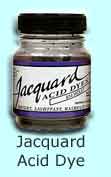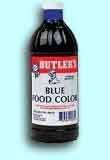Advertisements
Dye protein fibers with acid dyes

Jacquard Acid Dye at Amazon
excess dye


Butler's® Blue Food Color

Advertisements



Butler's® Blue Food Color

All of the pages on this site are copyright ©1998‑2026 Paula E. Burch, Ph.D.
Page created: May 5, 2003
Last updated: October 30, 2009
Downloaded: Tuesday, January 06, 2026